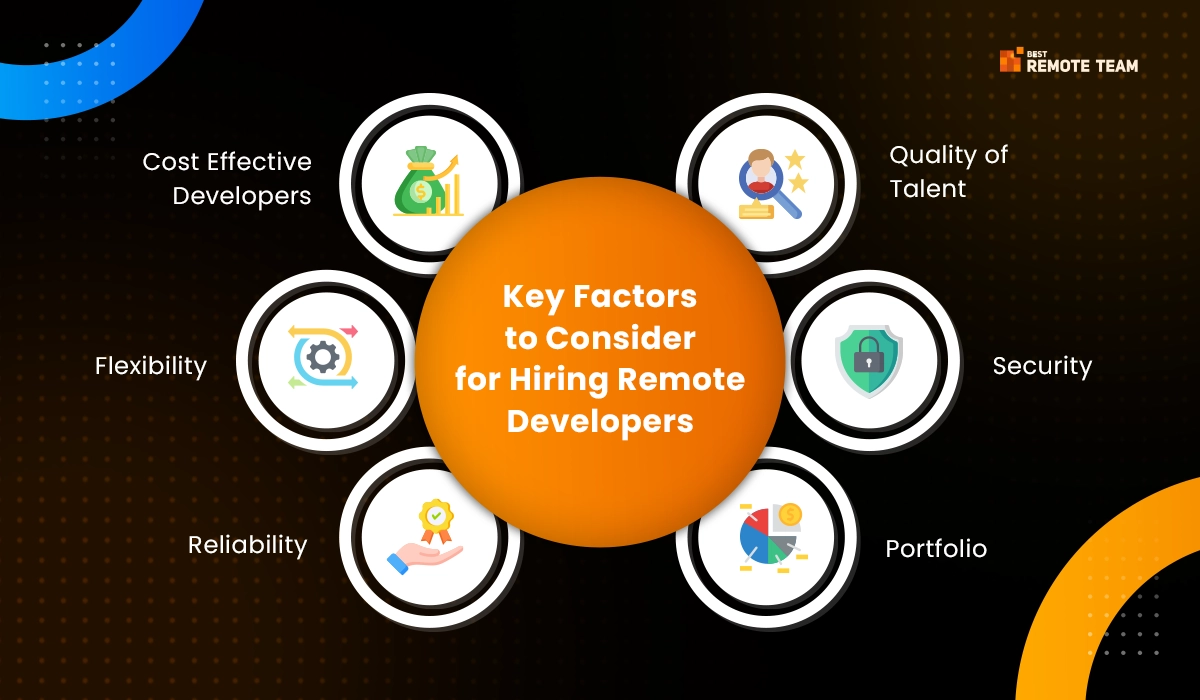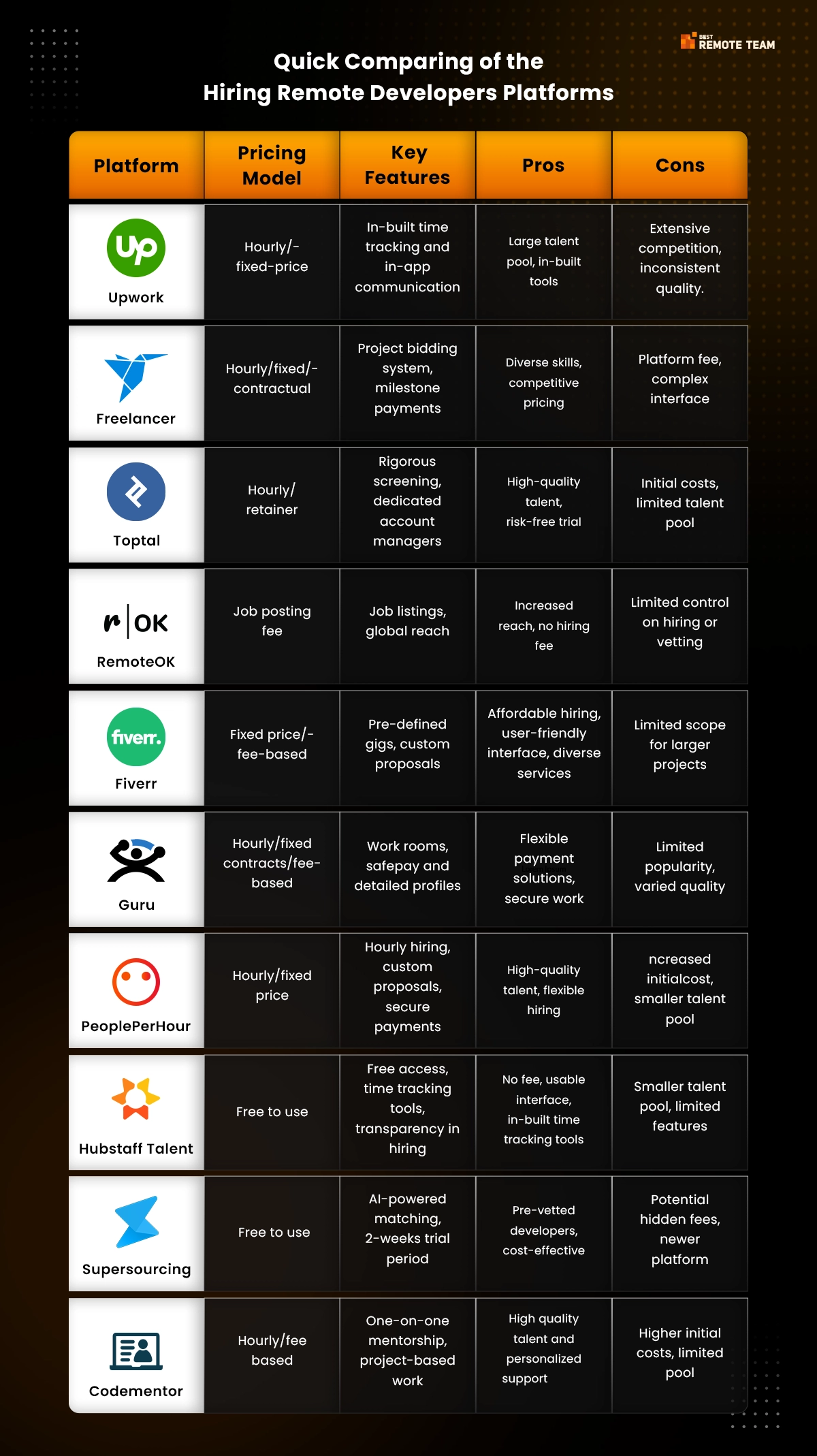6 Key Factors to Consider for Hiring Remote Developers in 2026
It is a good idea to choose the right hiring platforms for remote developer. This way you will find the quality and rates that you need. Here are some of the factors to help hire the right developers in 2026.
1. Cost Effective Developers
You must evaluate the platform for the pricing models they offer. Look for platforms that combine and extend multiple engagement models to make the process cost-efficient. Depending on the type of project, hourly rate or dedicated hiring can be efficient.
You must also assess if the platform has any hidden costs. This can increase the hiring expenses if you haven’t checked it already. So, make sure to learn all about additional expenses before getting started.
2. Quality of Talent
The quality of the people on your team is equally important. Not all platforms can offer the diversity and depth of skills you need. For instance, if you are particular about the technology you plan to use, you must look for developers skilled in it.
At the same time, you must look at the vetting procedures of the platforms. Do they actually look into the qualifications and skills of the developer before proceeding with putting their portfolio on the site?
Check the credibility of the platform by looking at the feedback from the users and the companies hiring developers. This would help ensure you are choosing the right place.
3. Flexibility
It is crucial to look for a platform where the hiring terms are flexible. Additionally, the remote workforce hiring should be flexible. You must be able to hire them for a long-term or short-term project.
Make sure to check if the workforce can support all types of projects. This could range from small projects to bigger tasks. Moreover, you must look into their availability and flexibility in offering support while hiring them.
4. Security
It is crucial to consider security when hiring a remote workforce from top platforms. You must ensure that payment methods are secure. This is crucial as you will either be transferring money in different currencies or managing multiple payment modes.
It is equally important to look for platforms that follow confidentiality policies and procedures. Moreover, they should adhere to the compliances that would maintain the integrity of sensitive information.
5. Reliability
The reputation of the platform is crucial for selecting the right people. You must focus on the history and their results to understand if they can offer you the people you need.
To hire the right team, you also need a platform that is consistent with offering high-quality and reliable services. they should vet and work with top-notch developers to be reliable.
6. Portfolio
The portfolio of your developers is crucial in judging and hiring the right team. You must look at their past work and achievements to understand if the platform offers the best hires.
You can also look for case studies and success stories to see the developer’s capability.
Top 10 Online Platforms for Hiring Remote Developers in 2026
If you want to hire remote developers in India, you must look at the top platforms that can help attain them. Here you will learn all about these platforms to help make the right choice.
1. Upwork
Upwork is a renowned platform that helps companies connect with freelancers and diverse remote developers. You can access global talent across multiple skills, such as writing, marketing and design.
They have vetted the applicants and offer skillsets ranging from beginners to experts.
Pricing Model
You can use multiple engagement models to hire freelancers from this platform. For instance, you can opt for hourly rates, and use the rates set forth by freelancers for this. Fixed price contracts are another way to engage the developers.
Upwork charges a specific service fee that is a percentage of the total billed amount. It is 10% for the first $500. The percentage reduces with the next few projects.
Key Features
- Upwork provides a time tracker that allows you to check on the total hours a developer has worked. You will be able to bill them for these hours, thus ensuring complete transparency.
- There is a provision for in-app communication via video calls and chats. You can even collaborate with the other teams and stakeholders through file sharing.
- The advanced filtering tools available with Upwork allow you to find the most suitable developers for your project.
- The client can set up milestone payments so that freelancers they have hired are paid at the end of specific phases.
Pros
- You get access to a large and global talent pool.
- The tools for project management and collaboration help you streamline the operations.
- They have ensured complete security of payments for both clients and freelancers.
- You can hire freelancers according to your needs.
Cons
- There is intense competition owing to the large number of freelancers, which makes it challenging to stand out.
- The service fee is slightly higher when you need to hire for small projects.
- The quality may not be consistent with your needs.
2. Freelancer
Freelancer is one of the top-notch hiring platforms where businesses can connect with high-quality freelancers and remote workforce. Akin to Upwork, they also offer multiple skills in a single place.
This platform seeks bids from the clients before supporting them with the suited team. The competitive bidding system ensures you get the most talented developer for your project.
Pricing Model
You can easily hire developers on an hourly basis on this marketplace. You need to pay the rates that the freelancers have set on the platform. You can also bid for fixed-price contracts by setting a price that is acceptable to the freelancers.
The platform, like all other marketplaces, charges a commission for fixed-price projects, a fee of 3% or ₹150.00 INR (whichever is greater), whichever works for the different projects. It depends on the engagement model you have chosen for the project.
Key Features
- The most significant feature of this platform is the bidding system. Clients can easily choose the developers based on expertise and their budget.
- The milestone payments allows flexibility in completing the project payments. You can pre-define the milestones and ensure payment accordingly.
- There are built-in time tracking tools that allow you to check the billed hours and complete the payments accordingly.
- The profiles are completely verified. There is a review and rating system, which makes it easier for you to check the profiles and understand their capabilities.
Pros
- You can access diverse skills and expertise across the globe.
- Freelancers can bid on projects, thus ensuring competitive rates for the projects.
- Milestone payments allow flexibility and satisfaction.
Cons
- You must pay a service fee in addition to the total project budget.
- The quality of freelancers depends on several factors and may not be consistent.
- The interface is not usable. It is highly complex and has a steep learning curve.
3. Toptal
Toptal is a platform that works with the top 3% of freelance developers and designers. The platform connects clients with freelancers using a rigorous screening process. This allows clients to get skilled and reliable talent for their projects.
Pricing Model
The hourly rates can help you hire and pay for the hours billed. You can also use this platform to connect with freelancers on a contractual basis. You can draw monthly or weekly contracts with the freelancers. There are no initial fees to be paid to access the talent on this platform.
Key Features
- The most significant feature of this platform is the rigorous screening via technical assessments and interviews.
- The personalized support the platform extends to clients helps them find the right freelancers.
- They offer a risk-free trial period, which helps ensure proper hiring processes.
- They are completely focused on long-term hiring.
Pros
- Get high-quality talent with the rigorous screening process.
- Personalized and prompt client support is available.
- Risk-free trial to find the right team for your project.
Cons
- The average rate for a Toptal freelancer is between $60 and $150 per hour.
- You may not access a diverse talent pool; it is restricted.
4. RemoteOK
RemoteOK is a job-board hiring platform that is available for remote positions. You will find several software development roles posted on this board. You can hire talent from across the globe, which is why it is one of the popular choices for businesses.
Pricing Model
You need to pay a $599 – $4,143 per post fee to post your jobs on this board. There are no service fees for accessing the board.
Key Features
- They have a simple and effective system of placing job postings. This listing will help you get the desired position.
- You can attract talent from across the globe to this job board.
- It easily integrates with several job boards and hiring tools.
Pros
- Excellent reach, which ensures maximum access to a large pool of remote workers.
- No hiring fees or additional charges.
- It is an easy-to-use interface.
Cons
- Limited control on vetting or selecting the candidates.
- Lacks in-built tools for management or collaboration.
5. Fiverr
This is one of the renowned hiring platforms where freelancers can showcase their portfolios and services. clients can find freelancers for diverse requirements on this platform, including developers. Freelancers create gigs on this platform that a client can buy.
Pricing Model
The gig model is a fixed-price solution, where starting from $5. This is the most popular model on Fiverr. Apart from that, the freelancers and clients can get together to create a custom offer.
The pricing model also includes the small percentage service fee (5.5%) that the platform charges. In case the orders are below $50, they would charge an order fee of $3 as well.
Key Features
- The gig model allows the clients to find their freelancers easily. Moreover, the fixed packages make the purchase fast.
- There are reviews and ratings that allows you to know if the freelancer is good for your project.
- You can go with custom offers for specific requirements and find someone who is capable.
- The payment model is secure and safe, thus ensuring complete adherence to the compliances.
- You can also go with the pro model, which extends premium services.
Pros
- The price points on Fiverr are affordable for all types of projects.
- It extends a user-friendly interface.
- You can use the service to choose diverse skills.
Cons
- The quality may not be consistent. You must look at the reviews before choosing someone.
- This model fits small to medium-sized projects.
- The extra service and order fee can make the whole project cost more.
6. Guru
Guru is a proper freelancing-only platform, where you can connect with freelancers across diverse industries. They also offer freelancers in the field of IT and software development. The flexible hiring options and secure payments make this platform incredible.
Pricing Model
They have extended diverse engagement models to help freelancers. For instance, you can use the hourly model if you want to hire them for a specific period. fixed price contracts allow you to complete the hiring for short and long-term projects.
You can also use the task-based pricing model, where you pay for each milestone achieved. The pricing model also includes a service fee of 2.9%, which depends on the freelancer’s membership.
Key Features
- There are work rooms on this platform, which are dedicated collaboration spaces. You can share files and discuss the project here.
- They have an escrow system that allows financial protection for both parties involved while completing the payments.
- The platform ensures that the clients get detailed profiles of all the freelancers for the best decision-making.
- There are in-built invoicing tools, which makes raising a bill swift and easy.
- There are different membership levels, which extend specific benefits. The freelancer is charged for these memberships.
Pros
- Flexible payment models, making it easier on the pockets.
- Choose from a diverse talent pool that has incredible skills and expertise.
- Use the workrooms for collaboration and secure payments.
Cons
- The popularity isn’t as much as other platforms, which is why the talent pool is limited.
- Quality isn’t consistent. You should look at the profiles, portfolio and rating before selection.
7. PeoplePerHour
You may have heard of this brilliant UK-based freelancing platform that connects businesses with talented people. Owing to its flexible engagement models, it has gained popularity among clients and freelancers.
Pricing Model
As the name suggests, the core pricing model is the hourly rate. You can hire freelancers for hourly contracts. However, this is not the only pricing model you get with this freelancing platform. You can also go with fixed-price models for specific contract needs.
The platform charges a service fee of 20% once the freelancer has earned their first $350. The subsequent service charges are 7.5% on each payment made.
Key Features
- The clients can set the tasks or freelancers the services for fixed prices. This can make hiring immediate.
- The freelancers have an option to submit custom proposals when bidding for the project.
- Escrow payment systems make it easier to complete the payments. It also ensures complete safety.
- There is an in-built rating and review system that helps you assess the quality of the freelancers.
- The platform also offers a verified status to the freelancers. You can also choose from this limited pool.
Pros
- With verified profiles, access a high-quality and completely vetted freelancer pool.
- The flexible hiring and custom proposals make it easier to choose the best freelancer.
- Secure payment systems to ensure quicker and safer payments.
Cons
- A smaller talent pool when compared with the other platforms.
- The initial service fees for the projects are higher.
8. Hubstaff Talent
This is one of the few free platforms that allows clients to hire a remote workforce without inhibitions. It is a completely transparent and usable platform. The no initial fee feature makes it an incredible platform to hire your workforce.
Pricing Model
The first part of the pricing model is that it is free to use and access. You don’t need to pay to get a membership. The platform doesn’t charge a membership fee either.
This ensures that the clients hire freelancers without paying any intermediary fee, thus saving them some money.
Key Features
- There is no cost associated with posting jobs or hiring freelancers.
- In-built time tracking tools allow you to know how many hours the freelancer has worked.
- Transparency in the profiles helps recognize the skills and experience available to the freelancers.
- The clients can directly communicate with the freelancers.
Pros
- No initial or membership fees are charged for hiring or building a profile.
- Simple and intuitive interface.
- In-built time tracking tools for easy billing.
Cons
- Limited talent pool of freelancers.
- Limited in-built tools and features.
9. Supersourcing
Supersourcing is a renowned platform that helps businesses find their top remote talent with proficiency in multiple technologies. You can source candidates across diverse skill sets and ensure high-quality hires.
Pricing Model
They offer a subscription-based pricing model that helps users access the features. You can also choose the custom pricing. The platform also charges upfront costs that you must pay once you have selected a candidate successfully.
Key Features
- The platform accepts only 1% of the applicants, ensuring high quality of the candidates.
- You get dedicated support from the account managers throughout hiring and afterward.
- You can get tailored recommendations from the platform relevant to your project and culture.
- Get a 2-week risk-free trial without the commitment that helps you find the right team.
Pros
- Fully vetted talent that moves through a rigorous testing process.
- Flexible pricing models that cater to your budget.
- Dedicated support in finding the right talent.
Cons
- Higher fees and one-time investment owing to subscription plans
- A very limited talent pool owing to stringent vetting process.
10. Codementor
This platform connects skilled developers with businesses with diverse requirements. you can get one-on-one mentorship. You may also hire them for freelance projects and long-term engagements.
This platform assures high-quality and personalized support when you hire a remote developer for the project.
Pricing Model
You can choose the hourly rate model, where freelancers are hired for projects or mentorship for specific hours. you can also use the fixed price engagement model to complete the hiring. There are no additional fees on this platform.
Key Features
- The platform allows you to get personalized support and guidance from experienced developers.
- You can hire developers for specific projects or tasks.
- High-quality vetting process allows you to source the best developers.
- Flexible engagement models to ensure smooth hiring for diverse requirements.
- Secure payment systems for safe and timely transactions.
Pros
- Access high-quality and fully vetted talent.
- Get personalized support and guidance.
- Use flexible hiring models to find the right remote developer.
Cons
- Smaller talent pool as compared to others.
6 Proven Tips for Successfully Hiring Remote Developers in 2026
Now that you have a clear idea of your requirements, budget, and management and communication strategy for your remote developers, it’s time to get down to the specifics of hiring them.
1. Decide Which Search Area You Want To Focus On
Where will you search for the next member of your team? Although hiring someone remotely allows you to do so from anywhere in the world, labor costs, talent availability, and time zone differences should limit your options.
2. Write A Job Description
A job description helps prospective employees understand your requirements and whether they would be a good fit for you. It should therefore be as simple and uncomplicated as possible, using as little marketing or business jargon as feasible.
3. Attract Potential Candidates
It’s time to announce your need for a remote developer to the world, and more importantly, to your ideal candidates:
- Social media
- Job portals
- Recruitment/Developer agencies
- Development companies
4. Examine The Candidates
As soon as applications begin to come in, it’s time to sort through them and shortlist applicants who best fit the fundamental requirements listed in the job description. Either a manual process or an application tracking system (ATS) can be used for this step.
5. Test The Shortlisted Specialists’ Technical Skills
Following the initial screening, you can identify the candidates who possess the soft skills required to be productive remote workers and who will be a good addition to your team.
- Technical interview
- Exam or test
- Trial project
- Pair programming session
6. Finalize The Interview Process & Select Your Developer
The top candidates—those who have demonstrated they are a good fit for you both in terms of technical proficiency and soft skills—will be invited to the final interview.
Conclusion
Upwork, Freelancer and Fiverr host a broad range of talent with competitive pricing. As a result, they are suited for all project sizes. Best Remote Team makes sourcing and vetting completely transparent, ensuring the best remote workers for your project.
Toptal is renowned for its high quality, while Hubstaff Talent comes with zero service fee. If you want mentorship and development services tied into one, you may want to seek help from the code mentor platform.
Overall, each of these platforms has its best features and flip sides. You need to weigh in on these aspects before making the choice.
It is crucial to define the project size, budget and type of developers you need before choosing hiring platforms. When you are clear about your needs, you will know the best platform that will support you and complete the hiring.






